
Racing the Beam: The Atari Video Computer System
by
Nick Montfort
and
Ian Bogost
Published 9 Jan 2009
Racing the Beam Platform Studies Ian Bogost and Nick Montfort, editors Racing the Beam: The Atari Video Computer System, Nick Montfort and Ian Bogost, 2009 Racing the Beam The Atari Video Computer System Nick Montfort and Ian Bogost The MIT Press Cambridge, Massachusetts London, England © 2009 Nick Montfort and Ian Bogost All rights reserved. No part of this book may be reproduced in any form by any electronic or mechanical means (including photocopying, recording, or information storage and retrieval) without permission in writing from the publisher. For information about special quantity discounts, please email special_sales@mitpress.mit.edu This book was set in Filosofia and Helvetica Neue by SNP Best-set Typesetter Ltd., Hong Kong.
…
For information about special quantity discounts, please email special_sales@mitpress.mit.edu This book was set in Filosofia and Helvetica Neue by SNP Best-set Typesetter Ltd., Hong Kong. Printed and bound in the United States of America. Library of Congress Cataloging-in-Publication Data Montfort, Nick. Racing the beam : the Atari video computer system / Nick Montfort and Ian Bogost. p. cm — (Platform studies) Includes bibliographical references and index. ISBN 978-0-262-01257-7 (hardcover : alk. paper) 1. Video games—Equipment and supplies. 2. Atari 2600 (Video game console) 3. Computer games—Programming. 4. Video games— United States—History. I. Bogost, Ian. II. Title. TK6681.M65 2009 794.8—dc22 2008029410 10 9 8 7 6 5 4 3 2 1 Contents Series Foreword vii Acknowledgments ix Timeline xi 1 Stella 1 2 Combat 3 Adventure 4 Pac-Man 65 5 Yars’ Revenge 81 6 Pitfall!
…
Kirschenbaum, Jane McGonigal, Jill Walker Rettberg, and Jim Whitehead. We greatly appreciate the work that Roger Bellin and Dexter Palmer did in organizing the Form, Culture, and Video Game Criticism conference at Princeton University on 6 March 2004. This conference prompted the first scholarship leading to this book. Thanks also to students in Ian Bogost’s Videogame Design and Analysis class on the Atari VCS (Georgia Tech, Spring 2007): Michael Biggs, Sarah Clark, Rob Fitzpatrick, Mark Nelson, Nirmal Patel, Wes St. John, and Josh Teitelbaum. Thanks as well to Peter Stallybrass and the participants in his History of Material Texts Workshop at the University of Pennsylvania.
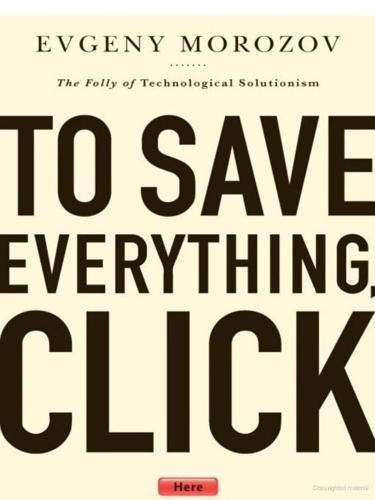
To Save Everything, Click Here: The Folly of Technological Solutionism
by
Evgeny Morozov
Published 15 Nov 2013
(Cambridge, MA: MIT Press, 2012). 329 “If we abandon the notion”: ibid., Kindle location 2449–2452. 330 One is the Spore 1.1 project: see http://www.swamp.nu/projects/spore-1–1; Douglas Easterly and Matt Kenyon, “Spore 1.1,” in ACM SIGGRAPH 2005 Emerging Technologies, SIGGRAPH ‘05 (New York: ACM, 2005), http://doi.acm.org/10.1145/1187297.1187316. 330 “a symbol of life and ecology” has become “trapped inside a synthetic ecosystem”: ibid. 330 DiSalvo’s other memorable example of adversarial design is the Natural Fuse: see http://www.haque.co.uk/naturalfuse.php. 332 “By design, the system enables and almost requires users”: DiSalvo, Adversarial Design, Kindle location 1997–1998. 332 “instead of using design as a means of providing a solution”: ibid., Kindle location 2018–2019. 333 Sociologist Anthony Giddens distinguishes: see chapter 2 of Anthony Giddens, The Constitution of Society: Outline of the Theory of Structuration (Berkeley: University of California Press, 1986). 334 As game theorists Ian Bogost has shown: Ian Bogost, Persuasive Games: The Expressive Power of Videogames (Cambridge, MA: MIT Press, 2007). 334 “But who cares about deliberation”: Ian Bogost, “Persuasive Games: Shell Games,” Gamasutra, March 3, 2010, http://www.gamasutra.com/view/feature/132682/persuasive_games_shell_games.php. 334 Zamzee is a game: see https://www.zamzee.com. 334 a fourteen-year-old who got two hundred points for walking his dog: Madison Park, “Gaming Reality,” CNN.com, August 2012, http://www.cnn.com/interactive/2012/08/tech/gaming.series/obesity.html. 335 a game like Fatworld: see http://www.persuasivegames.com/games/game.aspx?
…
(New York: Penguin, 2011). 307 “help ordinary people achieve”: ibid., Kindle location 332–334. 307 “You know that a new fad herbal supplement”: Steven Poole, “Opinion: Devastating Humanism,” EDGE, March 12, 2012, http://www.edge-online.com/features/opinion-devastating-humanism. 308 “The real world just doesn’t offer”: McGonigal, Reality Is Broken, Kindle location 121–123. 308 “Computer and video games are fulfilling”: ibid., Kindle location 146–147. 308 “What if we decided to use everything”: ibid., Kindle location 199–201. 308 “personal mission to see a game developer win a Nobel Peace Prize”: ibid., Kindle location 237–238. 308 “Compared with games, reality is too easy”: ibid., Kindle location 400–401. 309 “Compared with games, reality is unproductive”: ibid., Kindle location 951–952. 309 “The great challenge for us today”: ibid., Kindle location 5777–5778. 310 headlines like “PS3 Gamers Trying to Save the World”: ibid., Kindle location 3893–3894. 311 “What begins as a market mechanism”: Sandel, What Money Can’t Buy, 61. 312 “To decide where the market belongs”: ibid., 10. 312 “the makeover London commuting has been waiting for”: Jemima Kiss, “Chromaroma: The Makeover London Commuting Has Been Waiting For,” The Guardian, November 30, 2010, http://www.guardian.co.uk/media/pda/2010/nov/30/chromaroma-oyster-transport-gaming. 312 “actually, the makeover London commuting has been waiting for”: Steve Poole, “Nil Point,” Edge Magazine, March 25, 2011, http://www.edge-online.com/features/nil-point. 313 “Factory competitions could blend fuzzily”: Mark Nelson, “Soviet and American Precursors to the Gamification of Work,” Proceedings of the 16th International Academic MindTrek Conference, pp. 23–26. Available at SSRN: http://ssrn.com/abstract=2115483. 313 “A despot in a sorcerer’s hat”: Ian Bogost, “Shit Crayons,” Ian Bogost’s blog, undated, http://www.bogost.com/writing/shit_crayons.shtml. 314 “Behind the allure of the quantified self”: Gary Wolf, “The Data-Driven Life,” New York Times, April 28, 2010, http://www.nytimes.com/2010/05/02/magazine/02self-measurement-t.html. 314 “We don’t have a pedometer in our feet”: ibid. 315 “the social web can’t exist”: quoted in Julianne Pepitone, “Facebook Is Now Too Big to Buy,” CNNMoney, November 8, 2011, http://money.cnn.com/2011/11/08/technology/zuckerberg_charlie_rose/index.htm. 315 “MySpace is about being someone fake”: quoted in Holman Jenkins, “Technology = Salvation,” Wall Street Journal, October 9, 2010, http://online.wsj.com/article/SB10001424052748704696304575537882643165738.html. 315 “Expressing our authentic identity”: “United States: Sharing to the Power of 2012,” The Economist, November 17, 2011, http://www.economist.com/node/21537000. 315 “Profiles will no longer be outlines”: ibid. 315 as Lionel Trilling showed: Lionel Trilling, Sincerity and Authenticity (Cambridge, MA: Harvard University Press, 1972). 315 as Trilling correctly noted: Trilling et al., “Sincerity and Authenticity: A Symposium,” Salmagundi 41 (1978): 87–110. 315 “of proving ourselves not merely good”: ibid., 98. 316 “with a kind of dress, with faded denims”: ibid., 96. 316 “in the name of contemporary authenticity”: Theodor Adorno, The Jargon of Authenticity (Oxford: Psychology Press, 2006), 102. 316 “What is crucial about authenticity”: Charles Guignon, On Being Authentic (Oxford: Psychology Press, 2004), 81. 317 “the unique American individual”: Abigail Cheever, Real Phonies: Cultures of Authenticity in Post–World War II America.
…
What is the connection between gamification and games? Some critics of gamification point out that the best video games are not exhausted by their reward systems. Virtual points do not produce experiences “of interest, enlightenment, terror, fascination, hope, or any number of other sensations,” as game theorist Ian Bogost puts it; rather, those are produced by the content of the game and various narrative strategies adopted by game designers. In other words, one doesn’t have to hate games to hate gamification; that process doesn’t, strictly speaking, turn everything into a game—it turns everything into limited (and often completely unimportant) factors that we sometimes associate with games.

What Algorithms Want: Imagination in the Age of Computing
by
Ed Finn
Published 10 Mar 2017
A cathedral is a space for collective belief, a structure that embodies a framework of understandings about the world, some visible and some not. This is a useful metaphor for understanding the relationship we have with algorithms today. Writing in The Atlantic in early 2015, digital culture critic and game designer Ian Bogost called out our increasingly mythological relationship with software in an article titled “The Cathedral of Computation.” Bogost argues that we have fallen into a “computational theocracy” that replaces God with the algorithm: Our supposedly algorithmic culture is not a material phenomenon so much as a devotional one, a supplication made to the computers people have allowed to replace gods in their minds, even as they simultaneously claim that science has made us impervious to religion.8 We have, he argues, adopted a faith-based relationship with the algorithmic culture machines that navigate us through city streets, recommend movies to us, and provide us with answers to search queries.
…
As algorithms become more adept at reading cultural data and performing real-time arbitrage (used here in the sense of financial pricing arbitrage but also cultural arbitrage as described in the previous chapter), they are taking on new forms of intellectual labor. They are authoring and creating, but they are also simplifying and abstracting, creating an interface layer between consumers and the messy process of, say, getting a cab or hiring a housekeeper. Chapter 4 begins with Ian Bogost’s satirical Facebook game Cow Clicker and its send-up of the “gamification” movement to add quantification and algorithmic thinking to many facets of everyday life. Such games trouble the boundaries between work and play, as do much more serious forms of gamification like Uber and the high-tech warehouse workers whose every second and step are measured for efficiency.
…
Even the engineers behind some of the most successful and ubiquitous algorithmic systems in the world—executives at Google and Netflix, for example—admit that they understand only some of the behaviors their systems exhibit. But their rhetoric is still transcendent and emancipatory, striking many of the same techno-utopian notes as the mythos of code as magic when they equate computation with transformational justice and freedom. The theology of computation that Ian Bogost identified is a faith militant, bringing the gospel of big data and disruption to huge swaths of society. This is the context in which we use algorithms today: as pieces of quotidian technical magic that we entrust with booking vacations, suggesting potential mates, evaluating standardized test essays, and performing many other kinds of cultural work.
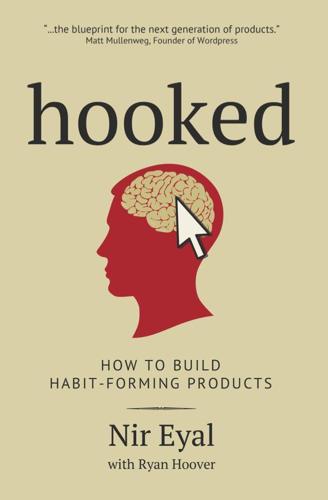
Hooked: How to Build Habit-Forming Products
by
Nir Eyal
Published 26 Dec 2013
We call these people users and even if we don’t say it aloud, we secretly wish every one of them would become fiendishly hooked to whatever we’re making. I’m guessing that’s likely why you started reading this book. Users take their technologies with them to bed.2 When they wake up, they check for notifications, tweets, and updates, sometimes even before saying “Good morning” to their loved ones. Ian Bogost, the famed game creator and professor, calls the wave of habit-forming technologies the “cigarette of this century” and warns of their equally addictive and potentially destructive side effects.3 You may be asking, “When is it wrong to manipulate users?” Manipulation is an experience crafted to change behavior—we all know what it feels like.
…
Certainly, there is money to be made addicting users to behaviors that do little more than extract cash; and where there is cash, there will be someone willing to take it. The question is: Is that someone you? Casinos and drug dealers offer users a good time, but when the addiction takes hold, the fun stops. In a satirical take on Zynga’s FarmVille franchise, Ian Bogost created Cow Clicker, a Facebook game in which users did nothing but incessantly click on virtual cows to hear a satisfying moo.11 Bogost intended to lampoon FarmVille by blatantly implementing the same game mechanics and viral hacks he thought would be laughably obvious to users. But after the app’s usage exploded and some people became frighteningly obsessed with the game, Bogost shut it down, bringing on what he called the “Cowpocalypse.”12 Bogost rightfully compared addictive technology to cigarettes.
…
Balz, “Choice Architecture” (SSRN Scholarly Paper, Rochester, New York), Social Science Research Network, (April 2, 2010), http://papers.ssrn.com/abstract=1583509. 2. Charlie White, “Survey: Cellphones vs. Sex—Which Wins?,” Mashable (accessed), http://mashable.com/2011/08/03/telenav-cellphone-infographic. 3. Ian Bogost, “The Cigarette of This Century,” Atlantic (June 6, 2012), http://www.theatlantic.com/technology/archive/2012/06/the-cigarette-of-this-century/258092/. 4. David H. Freedman, “The Perfected Self,” Atlantic (June 2012), http://www.theatlantic.com/magazine/archive/2012/06/the-perfected-self/308970/. 5.
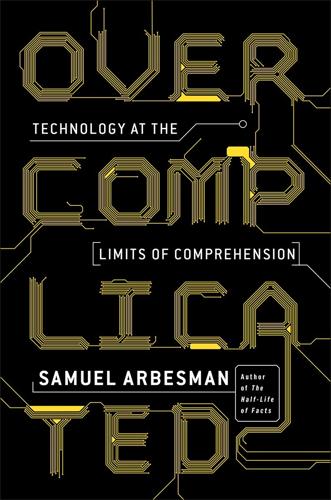
Overcomplicated: Technology at the Limits of Comprehension
by
Samuel Arbesman
Published 18 Jul 2016
Haldane, Possible Worlds and Other Essays (London: Chatto & Windus, 1928), 286. limitations to what we can know: For a further discussion on scientific humility, see Marcelo Gleiser, The Island of Knowledge: The Limits of Science and the Search for Meaning (New York: Basic Books, 2014). video game designer and writer Ian Bogost: Ian Bogost, “The Cathedral of Computation,” The Atlantic, January 15, 2015, http://www.theatlantic.com/technology/archive/2015/01/the-cathedral-of-computation/384300/. a perfect and immaculate process: This is discussed further in Bogost, “Cathedral of Computation.” the “humble programmer”: Edsger Dijkstra, “The Humble Programmer.”
…
As mentioned in the introduction, as our technologies become more complicated, and we lose the ability to understand them, our responses tend toward two extremes: fear and awe. Contemplating a fantastically intricate technological system, some of us are overwhelmed by its power and complexity, and respond with fear of the unknown. Others tend toward an almost religious reverence when faced with technology’s beauty and power. The video game designer and writer Ian Bogost has even suggested that replacing the term “algorithm” with the word “God” changes little of what is being said about technology in today’s discourse. But technology, while it suffuses our society, is not the product of a perfect and immaculate process. Technologies are kluges. They are messes cobbled together over time from many pieces, and while they are indubitably exciting, they do not merit unquestioning wonder or profound existential concern.
…
Will Oremus, “Who Controls Your Facebook Feed,” Slate, January 3, 2016, http://www.slate.stfi.re/articles/technology/cover_story/2016/01/how_facebook_s_news_feed_algorithm_works.html. because of its creation by some perfect, infinite mind: “The worship of the algorithm” is discussed further in Ian Bogost, “The Cathedral of Computation,” The Atlantic, January 15, 2015, http://www.theatlantic.com/technology/archive/2015/01/the-cathedral-of-computation/384300/. CHAPTER 1: WELCOME TO THE ENTANGLEMENT the Challenger disaster: James Gleick, “Richard Feynman Dead at 69; Leading Theoretical Physicist,” The New York Times, February 17, 1988, http://www.nytimes.com/books/97/09/21/reviews/feynman-obit.html.

You've Been Played: How Corporations, Governments, and Schools Use Games to Control Us All
by
Adrian Hon
Published 14 Sep 2022
As for implementation, the general mechanisms of gamification are so simple and well defined that competent programmers can introduce them to existing applications within months if not weeks, with white-label gamification platforms such as Bunchball existing as early as 2007. So, if there’s little cost to add gamification to your new app, why not try it? That’s why you’ll spot generic gamification almost anywhere you look. Dr. Ian Bogost, game designer and professor at Washington University in St. Louis, Missouri, has noted that gamification’s apparent simplicity and smoothness has led people to believe “the wild, magical beast of games can be tamed and integrated into any other context at low cost and high scale.”12 This leads into the second reason: by limiting itself to seemingly impartial and “clean” digital data like GPS traces and structured data submitted through forms, generic gamification allows for automatic and instant judgements.
…
One member of a Reddit community for Amazon fulfillment center workers complained of a screen instructing them to perform “Savoring,” in which they were told to “close your eyes and think about something that makes you happy.”26 Companies that treat their workers like the robots they wish to replace them with also motivate workers by telling them they’re part of a greater mission. They call workers “industrial athletes” and ask them for their loyalty, but as academic and game designer Ian Bogost has noted, “They reciprocate that loyalty with shams, counterfeit incentives that neither provide value nor require investment.”27 The sham is the baubles of gamification—or as he prefers to call it, exploitationware. Whatever it’s called, workplace gamification doesn’t need to be fun. It doesn’t need to grow skills.
…
Unsurprisingly, the value of indulgences also became inflated, with some questionable indulgences claiming as many as fifty-six thousand years off purgatory for a set of prayers.29 It seems incredible anyone believed this, and yet today people believe in equally ludicrous gamified diet plans or brain training regimens. Indulgences weren’t accepted by everyone. Long before Luther, indulgences were criticised and even parodied, much as commentators like Ian Bogost and TV shows like Black Mirror have done for gamification. From the fourteenth century, John Wyclif and the Lollards criticised indulgences for their commodification (in one case, one egg commuted two years of penance), their lack of scriptural support, and crucially, the pope’s lack of charity in requiring money rather than awarding indulgences to everyone.30 Some thought that an undue focus on pilgrimages and amulets and indulgences distracted from doing good deeds at home, similar to modern arguments that gamification’s focus on extrinsic rewards erodes intrinsic motivation.
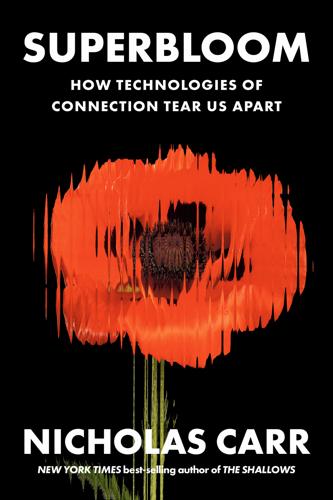
Superbloom: How Technologies of Connection Tear Us Apart
by
Nicholas Carr
Published 28 Jan 2025
The anxiety and enervation such crowding produces make the internet’s antisocial tendencies all the more pronounced. “With the advent of social media,” Joinson and a group of his colleagues wrote in the book Privacy Online, “it is inevitable that we will end up knowing more about people, and also more likely that we end up disliking them because of it.”21 Ian Bogost, a computer-science and media-studies professor at Washington University in St. Louis, is blunter. Social media, he wrote in a 2022 Atlantic essay, plunges us into a “sociopathic rendition of human sociality.”22 Chapter 6 The Democratization Fallacy Medium of the Masses So: 1.Content collapses, as analog media’s regulatory regime and epistemic architecture give way to digitization’s totalizing advance. 2.Media technology extends beyond its traditional transport function to assume an editorial role, automating judgments about the relevance and quality of information. 3.People streamline their writing and reading to optimize their efficiency as transceivers of messages on a high-speed communication network. 4.Social media encourages unchecked self-expression, greatly expanding the platforms’ supply of content but producing feelings of envy, enmity, and claustrophobia among individuals.
…
By telling ourselves that corporate malfeasance has perverted the net, yanked it off its true course, we open a loophole for self-deception. We give ourselves permission to continue to believe in the democratization fallacy. What’s broken can be fixed. What’s off course can be put back on track. We see signs of this attitude in the growing sense of nostalgia about the internet. When Ian Bogost described the “sociopathy” of social media in his 2022 Atlantic article, he also expressed a yearning for a time, before the giant platforms took over, when the net was a “truly magical” place, a greenfield of social connection.52 The early days of the web “were amazing,” tweeted then Twitter CEO Jack Dorsey that same year.
…
Miller (Newbury Park, CA: Sage, 1987), 257–277. 17.Irwin Altman et al., “Dialectic Conceptions in Social Psychology: An Application to Social Penetration and Privacy Regulation,” Advances in Experimental Social Psychology 14 (1981): 107–160. 18.Ibid. 19.Georg Simmel, “The Metropolis and Mental Life,” in The Blackwell City Reader (Chichester, UK: Blackwell, 2010), 106. 20.See, e.g., Elisabeth Mangrio and Slobodan Zdravkovic, “Crowded Living and Its Association with Mental Ill-Health among Recently-Arrived Migrants in Sweden,” BMC Research Notes 11 (2018): 609. 21.Adam N. Joinson et al., “Digital Crowding: Privacy, Self-Disclosure, and Technology,” in Privacy Online, ed. Sabine Trepte and Leonard Reinecke (Berlin: Springer, 2011), 33–45. 22.Ian Bogost, “The Age of Social Media Is Over,” Atlantic, November 10, 2022. Chapter 6: The Democratization Fallacy 1.Reno v. ACLU, 521 U.S. 844 (1997). 2.Francis Fukuyama, “The End of History?,” National Interest, Summer 1989. 3.Frances Cairncross, The Death of Distance (Boston: Harvard Business School Press, 1997), xvi. 4.Douglas Rushkoff, Open Source Democracy: How Online Communication Is Changing Offline Politics (London: Demos, 2003). 5.Jeff Jarvis, “Argue with Me,” BuzzMachine, November 11, 2004. 6.Joe Trippi, The Revolution Will Not Be Televised: Democracy, the Internet, and the Overthrow of Everything (New York: Regan Books, 2004), 235. 7.Jay Rosen, “The People Formerly Known as the Audience,” Huffington Post, June 30, 2006. 8.Yochai Benkler, The Wealth of Networks: How Social Production Transforms Markets and Freedom (New Haven, CT: Yale University Press, 2006).
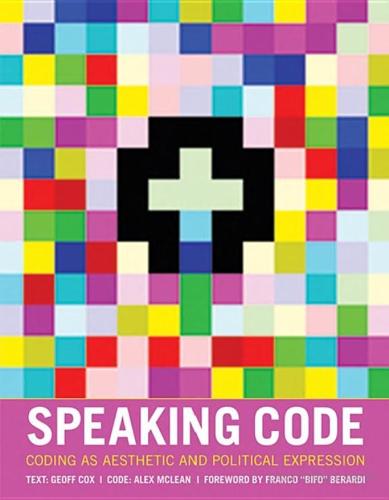
Speaking Code: Coding as Aesthetic and Political Expression
by
Geoff Cox
and
Alex McLean
Published 9 Nov 2012
As a noun, “program” is a description of a future event and a set of instructions used to execute a specified task. As a verb, it describes the process of the arrangement of the program as the expression but also the operation of the computer or machine in executing the instructions. The procedure is also ideological, as computational processes operate like other rhetorical strategies, something that Ian Bogost’s phrase “procedural rhetoric” makes clear in describing how computational processes (like good speeches) model persuasion in systems involving the interpretation of any symbolic system that governs thinking and action7—between sender and receiver, speaker and listener, writer and reader, programmer and user.
…
Georges Bataille, The Accursed Share, vol. 1, trans. Robert Hurley (New York: Zone Books, 1991). Excess is elementary to Bataille’s notion of “general economy” where expenditure (waste, sacrifice, or destruction) is considered more fundamental than the economies of production and utilities. 44. Ian Bogost, Unit Operations: An Approach to Videogame Criticism (Cambridge, MA: MIT Press, 2004), making reference to the work of Graham Harman in particular and what has become known as “speculative realism,” also associated with Ray Brassier, Iain Hamilton Grant, and Quentin Meillassoux. 45. Alain Badiou, Number and Numbers (Cambridge: Polity Press, 2008), 1.
…
See Karl Marx, “Fragment on Machines,” in Grundrisse: Foundations of the Critique of Political Economy (Rough Draft) (Harmondsworth: Penguin, 1981), 705–706. Notes to Pages 41–43 119 6. Hannah Arendt, “Labor, Work, Action” (1964), in The Portable Hannah Arendt (New York: Penguin 2000), 167–181. 7. Ian Bogost, “Procedural Rhetoric,” in Persuasive Games: The Expressive Power of Videogames (Cambridge, MA: MIT Press, 2007), 5. Bogost develops the idea of “unit operations” from this to describe an object-oriented approach (object-oriented ontology, in terms of both programming and philosophy), but the main issue here is to stress that computational representation and other cultural processes are bound together. 8.

Reality Is Broken: Why Games Make Us Better and How They Can Change the World
by
Jane McGonigal
Published 20 Jan 2011
Go too slow, and passengers miss their flights; go too quickly, and you might miss a banned item or let the wrong passenger slip by. The longer you play, the longer the line gets, the faster the security belt runs, and the harder it is to keep up with new security restrictions, like “no pressurized cheese,” “no pet snakes,” “no pudding cups,” and “no robots.” The game’s lead designer, Ian Bogost, is a frequent business traveler who came up with the idea for the game after suffering endless frustration in the security line himself. The game has a decidedly satirical bent, and player reviews often mention laughing out loud as they play.3 That’s one of the main goals of the game, Bogost told me: to make players laugh during a stressful situation.
…
All it needs are a few arbitrary limitations, some multiplayer obstacles, and a feedback system in order to turn unlocking the kindness of strangers into a game. So what exactly would a kindness game look like? And who would play it? These are questions I asked myself a few years ago, and, together with my good friend and fellow game developer Persuasive Games cofounder Ian Bogost, I decided to invent a game with the core mechanism of performing acts of kindness on strangers—as sneakily and stealthily as possible. It would work just like the popular college campus game Assassins, in which players are assigned targets via e-mail, and then proceed to stalk each other across campus for days or even weeks to eliminate their targets with water guns and other toy weapons.
…
CRUEL 2 B KIND, like many happiness hacks, isn’t a product. There’s no software to download, no license to buy, no fee to pay. It’s meant to be a solution to a problem—the problem of how to increase the jen ratio of a shared space—and it can be adopted and adapted by anyone, anywhere. It was cheap to invent—Ian Bogost and I worked for free, and the whole project probably cost us less than five hundred dollars in expenses to playtest and launch. The game can be played using any kind of mobile communications technology: text messaging, mobile e-mail, and Twitter are the most popular platforms for C2BK. To help spread the hack, the Cruel 2 B Kind website includes a few essential tools.
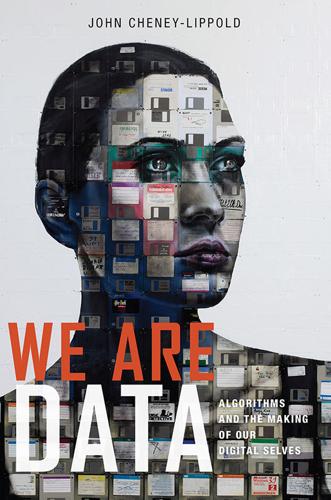
We Are Data: Algorithms and the Making of Our Digital Selves
by
John Cheney-Lippold
Published 1 May 2017
In our internetworked world, our datafied selves are tethered together, pattern analyzed, and assigned identities like ‘terrorist’ without attention to our own, historical particularities. As media scholar Mark Andrejevic writes, “such logic, like the signature strike, isn’t interested in biographical profiles and backstories, it does not deal in desires or motivations: it is post-narratival in the sense conjured up by [Ian] Bogost as one of the virtues of Object Oriented Ontology: ‘the abandonment of anthropocentric narrative coherence in favor of worldly detail.’”9 Yet even without an anthropocentric narrative, we are still narrativized when our data is algorithmically spoken for. We are strategically fictionalized, as philosopher Hans Vaihinger writes in his 1911 book The Philosophy of “As If”: “the purpose of the world of ideas as a whole is not the portrayal of reality . . . but to provide us with an instrument for finding our way about more easily in this world.”10 Importantly, those who use our data to create these ideas have the power to tell our “as if” stories for us.
…
Vaidhyanathan, Googlization of Everything, 84. 90. Friedrich Kittler, Discourse Networks, 1800/1900 (Stanford, CA: Stanford University Press, 1992). 91. Evgeny Dantsin, Thomas Eiter, Georg Gottlob, and Andrei Voronkov, “Complexity and Expressive Power of Logic Programming,” ACM Computing Surveys 33, no. 3 (2001): 374–425; Ian Bogost, Persuasive Games: The Expressive Power of Videogames (Cambridge, MA: MIT Press, 2007); Noah Wardrip-Fruin, Expressive Processing: Digital Fictions, Computer Games, and Software Studies (Cambridge, MA: MIT Press, 2009). 92. Kevin Kelly and Derrick de Kerckhove, “4.10: What Would McLuhan Say?
…
Tom Engelhardt, Shadow Government: Surveillance, Secret Wars, and a Global Security State in a Single-Superpower World (Chicago: Haymarket Books, 2014), 76. 8. Jo Becker and Scott Shane, “Secret ‘Kill List’ Proves a Test of Obama’s Principles and Will,” New York Times, May 29, 2012, www.nytimes.com. 9. Mark Andrejevic, “FCJ-187: The Droning of Experience,” Fibreculture Journal 25 (2015): 206; Ian Bogost, Alien Phenomenology, or, What It Is Like to Be a Thing (Minneapolis: University of Minnesota Press, 2012), 41–42. 10. Hans Vaihinger, The Philosophy of “As If”: A System of the Theoretical, Practical and Religious Fictions of Mankind (New York: Harcourt Brace, 1924). See also Curtis White, We, Robots: Staying Human in the Age of Big Data (New York: Melville House, 2015).

Coders: The Making of a New Tribe and the Remaking of the World
by
Clive Thompson
Published 26 Mar 2019
Hence the approval of universal health care—or even universal basic income, something that’s a warmly approved talking point at tech conferences. They’re happy to share some of the wealth via taxation but want to ensure nothing stops them in their process of how they amass their wealth. They believe that, fundamentally, they know what’s best for society: Their view is “trust us,” as the philosopher and technologist Ian Bogost says. And of course, it’s a redistributionist view that leaves their political power intact. Workers getting handouts from a small coterie of stratospherically wealthy 1 percenters are not liable to form any sort of strong counterweight to the power of tech giants. The vision is, in essence, that of a digital-age version of the robber baron.
…
Minecraft, these kids found, was a world where being able to build cool things out of logic was fun and made them impressive to the outside world. For these kids, Minecraft wasn’t just a game. It was this generation’s “personal computer,” their Commodore 64, as my friend the philosopher and game designer Ian Bogost once noted. It was the machine that let them peel back the curtain, see how digital stuff was really made, and start making it themselves. And since redstone creations often don’t work right the first time, you wind up learning the pain and pleasure of debugging, too. I’ve never seen any data on how many kids made the transition from redstone to actual programming.
…
Not all of them wound up in these pages, but each of their thoughts, observations, and stories helped inform all of my writing here. Along the way to writing Coders, I’ve been fortunate to talk to many brilliant folks who offered invaluable feedback and conversation. That includes Max Whitney, Fred Benenson, Tom Igoe, Michelle Tepper, Saron Yitbarek, Katrina Owens, Cathy Pearl, Tim O’Reilly, Caroline Sinders, Heather Gold, Ian Bogost, Marie Hicks, Anil Dash, Robin Sloan, danah boyd, Bret Dawson, Evan Selinger, Gary Marcus, Gabriella Coleman, Greg Baugues, Holden Karau, Jessica Lam, Karla Starr, Mike Matas, Paul Ford, Ray Ozzie, Ross Goodwin, Scott Goodson, Zeynep Tufekci, Steve Silberman, Tim Omernick, Emily Pakulski, Darius Kazemi, Cyan Banister, Craig Silverman, Chris Coyier, Chet Murthy, Chad Folwer, Brendan Eich, Lauren McCarthy, Annette Bowman, Allison Parrish, Dan Sullivan, Grant Paul, Guido van Rossum, Jens Bergensten, Mark Otto, Mitch Altman, Peter Skomoroch, Jimoh Ovbiagele and all the hackers at Ross Intelligence, Rob Graham, Steve Klabnik, Rob Liguori, Adam D’Angelo, Belle Cooper, Dug Song, Kim Zetter, David Silva, Sam Lang, Ron Jeffries, Susan Tan, and John Reisig.

Evil by Design: Interaction Design to Lead Us Into Temptation
by
Chris Nodder
Published 4 Jun 2013
(answers.yahoo.com) Obviously, online games such as World of Warcraft also encourage closure through leveling up and collection of in-game items, but the real trick lies in turning nongame tasks into a type of game (often referred to as gamification). Cow Clicker is the ultimate abstraction of this mechanism to its basic elements. Ian Bogost, a professor at Georgia Tech, created the Cow Clicker game within Facebook as a form of social commentary on gamification, the social gaming genre (of which he is not a fan) and the reward culture that it engenders. You get a cow. You can click it. In six hours, you can click it again. Clicking earns you clicks.
…
(Image from bogost.com) If this doesn’t make much sense to you, you probably aren’t a Farmville, Castleville, or Cityville fan. These games, all living inside Facebook and all created by one company, Zynga, combined to produce 12 percent of Facebook’s revenue in 2011. That’s $445 million funded entirely by Facebook users clicking on things. Obviously these games have slightly more content than Cow Clicker, but to Ian Bogost’s point, they are fundamentally designed to get users to click on things, and to worry about those things sufficiently that they come back and click some more, time and time again. An added twist is that users can reduce their level of worry (about whether their crops need watering, their cows need milking, and so on) by paying for in-game items to make their lives easier.
…
Proceedings of the 11th International Conference on Electronic Commerce. ACM, 2009. McAfee 12 percent claim: McAfee SECURE Service page (mcafeesecure.com). Retrieved November 2012. Help people complete a set Codecademy coding challenge: codeyear.com/stats. Retrieved February 2012. Cow Clicker: Ian Bogost. “Cow Clicker, The Making of Obsession” (bogost.com). July 21, 2012. Retrieved November 2012. Zynga 12% of Facebook’s 2011 revenue: Facebook S1 (Initial Public Offering) filing with the Securities and Exchange Commission, February 1 2012. Desire for order Light switches: “AWARE project.”
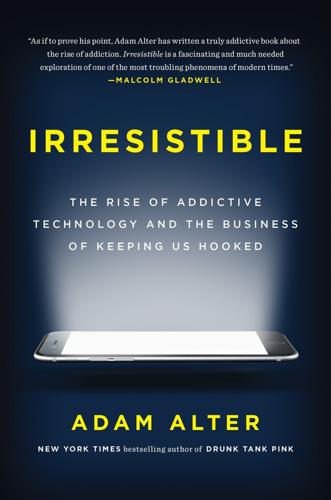
Irresistible: The Rise of Addictive Technology and the Business of Keeping Us Hooked
by
Adam L. Alter
Published 15 Feb 2017
In January 2016, the FTC fined Lumos Labs, one of the largest and most successful brain-training companies, $2 million. According to the FTC, Lumos had engaged in “deceptive advertising” of its software. It was possible that Lumos’ games warded off cognitive decline, but the evidence was scant, and Lumos had overclaimed. Even if gamification works, some critics believe it should be abandoned. Ian Bogost, a game designer at Georgia Tech, spearheads this movement. In 2011, he delivered a talk at a gamification symposium at Wharton. He titled his talk “Gamification Is Bullshit.” Bogost suggested that gamification “was invented by consultants as a means to capture the wild, coveted beast that is video games and to domesticate it.”
…
It gives medical patients respite from pain, schoolkids relief from boredom, and gamers an excuse to donate to the needy. By merely raising the number of good outcomes in the world, gamification has value. It’s a worthwhile alternative to traditional medical care, education, and charitable giving because, in many respects, those approaches are tone-deaf to the drivers of human motivation. But Ian Bogost was also wise to illuminate the dangers of gamification. Games like FarmVille and Kim Kardashian’s Hollywood are designed to exploit human motivation for financial gain. They pit the wielder of gamification in opposition to the gamer, who becomes ensnared in the game’s irresistible net. But, as I mentioned early in this book, tech is not inherently good or bad.
…
Federal Trade Commission Calls Brain-Training Claims Inflated,” January 8, 2016, ALZforum, www.alzforum.org/news/community-news/game-over-federal-trade-commission-calls-brain-training-claims-inflated; but note this statement from detractors: Stanford Center on Longevity and the Max Planck Institute for Human Development, “A Consensus on the Brain Training Industry from the Scientific Community,” October 20, 2014, longevity3.stanford.edu/blog/2014/10/15/the-consensus-on-the-brain-training-industry-from-the-scientific-community; a classic paper that explains why gamification may rob people of the intrinsic drive to behave in ways that benefit them: Uri Gneezy and Aldo Rustichini, “A Fine Is a Price,” Journal of Legal Studies 29 (January 2000): 1–18. Bogost demonstrated the: On Ian Bogost and Cow Clicker: The game’s site: cowclicker.com; Bogost’s own description of the game: bogost.com/writing/blog/cow_clicker_1/; see also: Jason Tanz, “The Curse of Cow Clicker: How a Cheeky Satire Became a Hit Game,” Wired, December 20, 2011, www.wired.com/2011/12/ff_cowclicker/all/1; interview with Bogost: NPR, “Cow Clicker Founder: If You Can’t Ruin It, Destroy It,” November 18, 2011, www.npr.org/2011/11/18/142518949/cow-clicker-founder-if-you-cant-ruin-it-destroy-it.
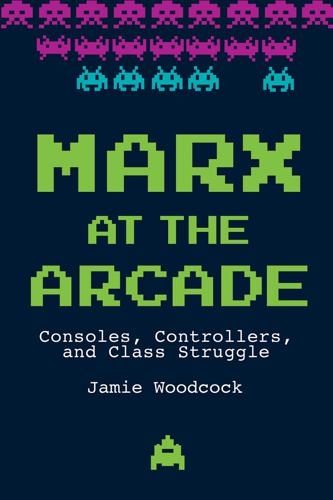
Marx at the Arcade: Consoles, Controllers, and Class Struggle
by
Jamie Woodcock
Published 17 Jun 2019
In terms of console games, this means understanding the determining effects of the “console game’s platform-dependent nature,” including the limitations of the hardware, software, game controllers, and graphical user interfaces. These standardize the game production process, closing down possibilities of the kinds of games that are commissioned and made. As Ian Bogost has explained, “These confines both facilitate and limit discursive production, just as the rules of natural languages bound poetry and the rules of optics bound photography.”50 The result is “two clearly discernible, complementary formatting strategies” for AAA games. The first is franchising, with regular serialization tied into publishing frameworks to maximize revenue.
…
They discovered that “more boys were playing video games than girls,” and as a result, “video games were about to be reinvented.”6 Videogame marketing and advertising became increasingly gendered—one obvious example is Nintendo’s decision to name its handheld videogame console the “Game Boy.” It was also evident in the way videogame protagonists and characters were advertised. Ian Bogost argues that Nintendo’s shift in the 1980s was a first key step that set the stage for “what we now call ‘dude-bro’ games happening in the early ’90s.”7 A 1998 ad that Sony ran for the PlayStation serves as an example of this second phase: A grown man sits in a movie theater with his girlfriend.
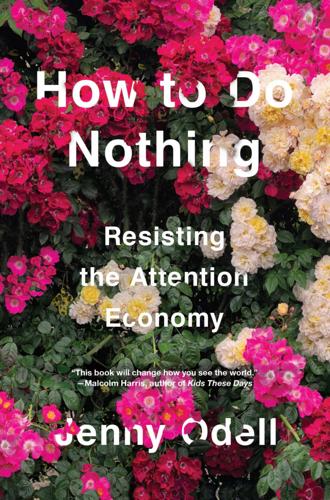
How to Do Nothing
by
Jenny Odell
Published 8 Apr 2019
As Oliver Leistert puts it in “The Revolution Will Not Be Liked,” for social media companies, “the public sphere is an historically elapsed phase from the twentieth century they now exploit for their own interests by simulating it.”16 * * * — WRITING IN THE ATLANTIC about a nascent decentralized network called Scuttlebutt, Ian Bogost gives us an image for this absurd situation: “Facebook and Twitter are only like water coolers if there were one, giant, global water cooler for all workplaces everywhere.”17 Dissatisfaction with this standard-issue water cooler has fueled the movement toward a decentralized web, which instead of private companies and servers makes use of peer-to-peer networks and open-source software.
…
Nextdoor, “Advertising on Nextdoor”: https://ads.nextdoor.com/. 16. Oliver Leistert, “The Revolution Will Not Be Liked: On the Systemic Constraints of Corporate Social Media Platforms for Protests,” in Critical Perspectives on Social Media and Protest: Between Control and Emancipation (London: Rowman & Littlefield, 2015), 41. 17. Ian Bogost, “Meet the Nomad Who’s Exploding the Internet Into Pieces,” The Atlantic, May 22, 2017: https://www.theatlantic.com/technology/archive/2017/05/meet-the-counterantidisintermediationists/527553/. 18. Sudo Room, “Sudo Mesh”: https://sudoroom.org/wiki/Mesh. 19. People’s Open, “About”: https://peoplesopen.net/about/. 20.
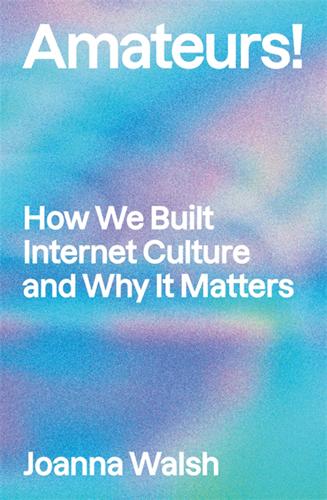
Amateurs!: How We Built Internet Culture and Why It Matters
by
Joanna Walsh
Published 22 Sep 2025
Bridle shut his Tumblr, temporarily, in the wake of an overload of reaction to Sterling’s piece, which included both criticism of the New Aesthetics’ apparently apolitical stance – and an excess of enthusiasm, which might have been down to the way Sterling compared Bridle to both Walter Benjamin and André Breton, codifier of Surrealism, the newest aesthetic of his day. Unlike Surrealism, the New Aesthetic doesn’t have a manifesto, 55as technologist Ian Bogost noted, or perhaps complained, in the Atlantic.2 Sterling’s and Bogost’s were the most high-profile responses that forced Bridle to develop some theory around his impulse to collect. In a 2013 blog post on his site booktwo.org – after what he considered a lot of ‘misreading’ – Bridle laid down some principles.
…
Thomas Docherty (Routledge, 1990), p. 250. 33.Failblog, cheezburger.com. 34.Mark Fisher, K-punk (Repeater Books, 2018), p. 545. 35.Claire Bishop, Disordered Attention (Verso, 2024), p. 18. 36.Rancière, Aesthetics and its Discontents, p. 20. 37.Ibid., p. 36. 38.Andrew LaVallee, ‘LOLcats CEO on Failure: “Part of Our Culture” ’, Wall Street Journal, 12 October 2009. 39.Rancière, Aesthetics and Its Discontents, p. 43. 40.‘Hungry but Too Tired to Cook?’, knowyourmeme.com. 41.John Cook, ‘Q&A: Ben Huh of I Can Has Cheezburger on tech, cats and more’, Venture Blog, 6 November 2008. 2011: The Old Aesthetic 1.Andrew Blum, ‘Children of the Drone’, Vanity Fair, 12 June 2013. 2.Ian Bogost, ‘The New Aesthetic Needs To Get Weirder’, Atlantic, 13 April 2012. 235 3.James Bridle, ‘The New Aesthetic and Its Politics’, booktwo.org, 12 June 2013. 4.Jason Kottke, ‘Tumblelogs’, kottke.org, 19 October 2005. 5.Bruce Sterling, ‘An Essay on the New Aesthetic’, Wired, 2 April 2012. 6.Blum, ‘Children of the Drone’. 7.Russell Davis, ‘something something something’, russelldavies.typepad.com, 5 October 2010. 8.Ibid. 9.Phil Gyford, ‘One of today’s futures’, gyford.com, 26 May 2011. 10.James Bridle, ‘The New Aesthetic and Its Politics’. 11.James Bridle, ‘The New Aesthetic (+10)’, booktwo.org, 6 May 2021. 12.Robert Jackson, ‘The Banality of the New Aesthetic’, furtherfield.org, 15 April 2012. 13.Hito Steyerl, ‘In Defence of the Poor Image’, e-flux.com, no. 10, November 2009. 14.John Ruskin, ‘Of the Turnerian Picturesque’, in Modern Painters (Knopf, 1987 [1843–60]), p. 427. 15.Ibid., p. 423. 16.Ibid., p. 432. 17.Joseph Addison, ‘Geneva and the Lake’, in Remarks on Several Parts of Italy etc. in the Years 1701, 1702, 1703 (T.

Terms of Service: Social Media and the Price of Constant Connection
by
Jacob Silverman
Published 17 Mar 2015
Facebook is a literal manifestation of the social factory. We do the work, by clicking, writing, posting, giving over our content, data, and attention. This work is diffused throughout our society, through our day jobs and entertainment and most basic communications. We might not even realize it’s work. The writer and game designer Ian Bogost describes this form of always-on but rarely acknowledged labor as “hyperemployment”: “We do tiny bits of work for Google, for Tumblr, for Twitter, all day and every day.” It’s enough to make one think that platform owners don’t do much at all. In digital serfdom, the digital lords appear to be little more than caretakers fattening themselves on our data production.
…
We’ve learned to deal with information overload by denying its existence or adopting it as a sociocultural value, sprinkled with a bit of the martyrdom of the Protestant work ethic. It’s a badge of honor now to be too busy, always flooded with to-do items. It’s a problem that comes with success, which is why we’re willing to spend so much time online, engaging in, as Ian Bogost called it, hyperemployment. There’s an inherent dissonance to all this, a dialectic that becomes part of how we enact the informational appetite. We ping-pong between binge-watching television and swearing off new media for rustic retreats. We lament our overflowing in-boxes but strive for “in-box zero”—temporary mastery over tools that usually threaten to overwhelm us.
…
“Craigslist Revenue, Profits Soar.” Aim Group. April 30, 2010. aimgroup.com/2010/04/30/craigslist-revenue-profits-soar. 264 “social factory”: Mark Andrejevic. “Estranged Free Labor.” In Digital Labor: The Internet as Playground and Factory. Trebor Scholz, ed. New York: Routledge, 2013, 159. 264 “We do tiny bits of work”: Ian Bogost. “Hyperemployment, or the Exhausting Work of the Technology User.” Atlantic. Nov. 8, 2013. theatlantic.com/technology/archive/2013/11/hyperemployment-or-the-exhausting-work-of-the-technology-user/281149. 265 “We do the work”: Will Oremus. “Facebookers of the World, Unite!” Slate. May 3, 2013. slate.com/articles/technology/books/2013/05/jaron_lanier_s_who_owns_the_future_review_facebookers_of_the_world_unite.single.html. 268 Resurgence of flânerie: Evgeny Morozov.
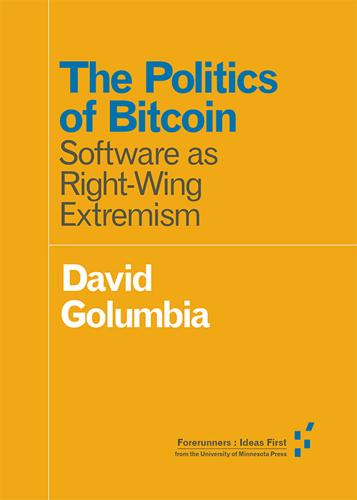
The Politics of Bitcoin: Software as Right-Wing Extremism
by
David Golumbia
Published 25 Sep 2016
Written between fresh ideas and finished books, Forerunners draws on scholarly work initiated in notable blogs, social media, conference plenaries, journal articles, and the synergy of academic exchange. This is gray literature publishing: where intense thinking, change, and speculation take place in scholarship. Ian Bogost The Geek’s Chihuahua: Living with Apple Andrew Culp Dark Deleuze Grant Farred Martin Heidegger Saved My Life David Golumbia The Politics of Bitcoin: Software as Right-Wing Extremism Gary Hall The Uberfication of the University John Hartigan Aesop’s Anthropology: A Multispecies Approach Mark Jarzombek Digital Stockholm Syndrome in the Post-Ontological Age Nicholas A.
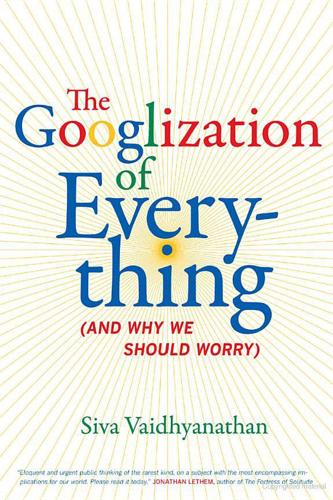
The Googlization of Everything:
by
Siva Vaidhyanathan
Published 1 Jan 2010
Robin Wauters, “Google Flags Whole Internet as Malware,” TechCrunch, January 31, 2009, www.techcrunch.com; “Search Is Too Important to Leave to One Company—Even Google,” www.guardian.co.uk, June 1, 2009; Liz Robbins, “Google Error Sends Warning Worldwide,” New York Times, January 31, 2009; Ian Bogost, “Cascading Failure: The Unseen Power of Google’s Malware Detection,” Ian Bogost, blog, June 12, 2009, www.bogost.com/blog; Jonathan Zittrain, The Future of the Internet and How to Stop It (New Haven, CT: Yale University Press, 2008). 7. Barry Schwartz, “First Google Image Result for Michelle Obama Pure Racist,” Search Engine Round Table, November 13, 2009, www.seroundtable.com/ archives/021162.html; David Colker, “Google Won’t Exclude Distorted Michelle Obama Image from Its Site,” Los Angeles Times, November 25, 2009; Judit BarIlan, “Web Links and Search Engine Ranking: The Case of Google and the Query ‘Jew’,” Journal of the American Society for Information Science and Technology 57, no. 12 (2006): 1581. 8.
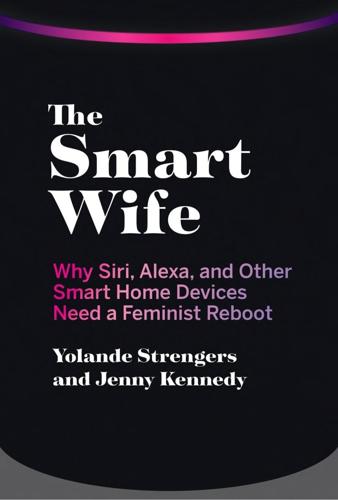
The Smart Wife: Why Siri, Alexa, and Other Smart Home Devices Need a Feminist Reboot
by
Yolande Strengers
and
Jenny Kennedy
Published 14 Apr 2020
Apple’s guidelines for Siri’s programming saw her responses explicitly rewritten to ensure she would say that she is in favor of “equality,” while never directly taking a stance on feminism. Explaining the decision, the guidelines state that “Siri should be guarded when dealing with potentially controversial content.”82 Feminism is indeed a controversial topic, especially when smart wives are involved. As professor of interactive computing and game designer Ian Bogost observes in his critique of Alexa’s feminist declaration, “It’s disingenuous to celebrate building ‘feminism’ into a product after giving a robot servant a woman’s voice.”83 Bergen makes a similar point about Siri, who she argues is “programmed to play the part of a neoliberal commodity.” Siri regularly reassures her users that she’s “not at all oppressed.”
…
Emily Chang, Brotopia: Breaking Up the Boys’ Club of Silicon Valley (New York: Portfolio, 2018); Sarah Myers West, Meredith Whittaker, and Kate Crawford, Discriminating Systems: Gender, Race, and Power in AI (New York: AI Now Institute, 2019), https://ainowinstitute.org/discriminatingsystems.pdf. 81. Ian Bogost, “Sorry, Alexa Is Not a Feminist,” Atlantic, January 24, 2018, https://www.theatlantic.com/technology/archive/2018/01/sorry-alexa-is-not-a-feminist/551291/. 82. Alex Hern, “Apple Made Siri Deflect Questions on Feminism, Leaked Papers Reveal,” Guardian, September 6, 2019, https://www.theguardian.com/technology/2019/sep/06/apple-rewrote-siri-to-deflect-questions-about-feminism. 83.

Why We Drive: Toward a Philosophy of the Open Road
by
Matthew B. Crawford
Published 8 Jun 2020
Sometimes, what you are doing when you drive your car isn’t very well captured by the term “transportation,” which suggests a simple point-to-point goal to be achieved with maximum efficiency. Such simplifications have always been the price paid for bringing new domains under technocratic control. Ian Bogost offers a convincing thought experiment about the terms on which the public will have access to roads as public infrastructure comes to be financed and planned by partnerships between municipalities and tech companies. “It’s easy to imagine that cross-town transit might soon require acceptance of non-negotiable terms of service that would allow your robocar provider to aggregate and sell where you go, when, with whom, and for what purpose.”
…
In November 2017 in Automotive News, Bob Lutz, the head of GM, suggested that driving will be outlawed in twenty years. Bob Lutz, “Kiss the Good Times Goodbye,” Automotive News, November 5, 2017, http://www.autonews.com/apps/pbcs.dll/article?AID=/20171105/INDUSTRY_REDESIGNED/171109944/industry-redesigned-bob-lutz. 7.Ian Bogost, “Will Robocars Kick Humans off City Streets?” Atlantic, June 23, 2016, https://www.theatlantic.com/technology/archive/2016/06/robocars-only/488129/. 8.A. M. Glenberg and J. Hayes, “Contribution of Embodiment to Solving the Riddle of Infantile Amnesia,” Frontiers in Psychology 7 (2016), as characterized in M.

New Laws of Robotics: Defending Human Expertise in the Age of AI
by
Frank Pasquale
Published 14 May 2020
Authoritarian propaganda has flooded news feeds and search results.16 Facebook may disclaim responsibility for the spread of stories falsely claiming that the Pope endorsed Donald Trump or that Hillary Clinton is a Satanist.17 Yet it has only taken on more responsibility for running political campaigns since then. As Alexis Madrigal and Ian Bogost have reported, “The company encourages advertisers to hand over the reins entirely, letting Facebook allot spending among ads, audiences, schedules, and budgets.”18 It also experiments with the content and appearance of ads. At some point, the AI is less finding audiences than creating them, less the conduit of a message than a coauthor of the message itself.
…
Guardian, December 17, 2016, https://www.theguardian.com/technology/2016/dec/17/holocaust-deniers-google-search-top-spot. 17. Sydney Schaedel, “Did the Pope Endorse Trump?” FactCheck.org, October 24, 2016, http://www.factcheck.org/2016/10/did-the-pope-endorse-trump/; Dan Evon, “Spirit Cooking,” Snopes, November 5, 2016, http://www.snopes.com/john-podesta-spirit-cooking/. 18. Ian Bogost and Alexis C. Madrigal, “How Facebook Works for Trump,” Atlantic, April 18, 2020, at https://www.theatlantic.com/technology/archive/2020/04/how-facebooks-ad-technology-helps-trump-win/606403/. For YouTube analysis by engineer Guillaume Chaslot, see Paul Lewis, “ ‘Fiction is Outperforming Reality’: How YouTube’s Algorithm Distorts Truth,” Guardian, February 2, 2018, https://www.theguardian.com/technology/2018/feb/02/how-youtubes-algorithm-distorts-truth. 19.

What to Think About Machines That Think: Today's Leading Thinkers on the Age of Machine Intelligence
by
John Brockman
Published 5 Oct 2015
BART KOSKO Thinking Machines = Old Algorithms on Faster Computers JULIA CLARKE The Disadvantages of Metaphor MICHAEL MCCULLOUGH A Universal Basis for Human Dignity HAIM HARARI Thinking About People Who Think Like Machines HANS HALVORSON Metathinking CHRISTINE FINN The Value of Anticipation DIRK HELBING An Ecosystem of Ideas JOHN TOOBY The Iron Law of Intelligence MAXIMILIAN SCHICH Thought-Stealing Machines SATYAJIT DAS Unintended Consequences ROBERT SAPOLSKY It Depends ATHENA VOULOUMANOS Will Machines Do Our Thinking for Us? BRIAN CHRISTIAN Sorry to Bother You BENJAMIN K. BERGEN Moral Machines LAURENCE C. SMITH After the Plug Is Pulled GIULIO BOCCALETTI Monitoring and Managing the Planet IAN BOGOST Panexperientialism AUBREY DE GREY When Is a Minion Not a Minion? MICHAEL I. NORTON Not Buggy Enough THOMAS A. BASS More Funk, More Soul, More Poetry and Art HANS ULRICH OBRIST The Future Is Blocked to Us KOO JEONG-A An Immaterial Thinkable Machine RICHARD FOREMAN Baffled and Obsessed RICHARD H.
…
We have almost 7 billion thinking machines on this planet already, but for the most part they don’t seem terribly concerned with how sustainable their life on this planet actually is. Few can see the whole picture in ways that make sense to them, and those who do are often limited in their ability to respond. Adding cognitive capacity to figure out how we fundamentally alter our relationship with the planet is a problem worth thinking about. PANEXPERIENTIALISM IAN BOGOST Ivan Allen College Distinguished Chair in Media Studies and Professor of Interactive Computing, Georgia Institute of Technology; founding partner, Persuasive Games LLC; author, Alien Phenomenology, or What It’s Like to Be a Thing The Search for Extra Terrestrial Intelligence (SETI) names the globally distributed projects, people, and institutions searching the cosmos for signs of intelligent life.
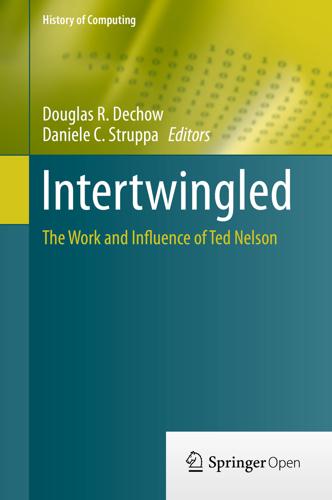
Intertwingled: The Work and Influence of Ted Nelson (History of Computing)
by
Douglas R. Dechow
Published 2 Jul 2015
We don’t assume, for example, that someone who is going to “read and write” the language of cinema should be concerned solely with shooting and editing their own films, never watching and critically interpreting existing films. Of course, there are those who have addressed, or at least identified, this gap. Michael Mateas’s call for “procedural literacy” is an early call for a critical literacy for computational media makers [8]. Ian Bogost’s “procedural rhetoric” draws on the history of rhetoric for a model of critically understanding and making processes [1]. And in recent years work on critical interpretation of computing, taking the technical level seriously, has blossomed. The MIT Press has been one of the leading supporters of this, initiating new book series in both software studies and platform studies.

Computer: A History of the Information Machine
by
Martin Campbell-Kelly
and
Nathan Ensmenger
Published 29 Jul 2013
Of the popular books on the video game industry, Steven Poole’s Trigger Happy (2000) and Scott Cohen’s Zap! The Rise and Fall of Atari (1984) offer good historical insights. Leonard Herman’s Phoenix: The Fall and Rise of Home Videogames (1997) contains a wealth of chronologically arranged data. Nick Montfort and Ian Bogost’s Racing the Beam (2009) represents the best of the emerging scholarship on video game platform studies. Page 206“simple enough to allow”: Kemeny and Kurtz 1968, p. 225. Page 208“That would leave, say, five years”: Licklider 1960, p. 132. Page 209“variously translated as”: Fano and Corbato 1966, p. 77.
…
McKenney, James L., with Duncan G. Copeland and Richard Mason. 1995. Waves of Change: Business Evolution Through Information Technology. Boston: Harvard Business School Press. Mollenhoff, Clark R. 1988. Atanasoff: Forgotten Father of the Computer. Ames: Iowa State University Press. Montfort, Nick, and Ian Bogost. 2009. Racing the Beam: The Atari Video Computer System. Cambridge, MA: MIT Press. Moody, Glyn. 2001. Rebel Code: Linux and the Open Source Revolution. New York: Perseus. Moore, Gordon E. 1965. “Cramming More Components onto Integrated Circuits.” Electronics 38 (19 April): 114–117. Moritz, Michael. 1984.

Gamification by Design: Implementing Game Mechanics in Web and Mobile Apps
by
Gabe Zichermann
and
Christopher Cunningham
Published 14 Aug 2011
Acknowledgments We want to recognize the game-design writing and work of key thinkers, including Jesse Schell’s The Art of Game Design: A Book of Lenses (Morgan Kaufmann), Jon Radoff’s Game On (Wiley), and Ralph Koster’s A Theory of Fun for Game Design (Paraglyph Press). We are also lucky to have been able to access and distill the insights of Sebastian Deterding, Susan Bonds, Jane McGonigal, Amy Jo Kim, Ian Bogost, Nick Fortugno, Nicole Lazzaro, Rajat Paharia, Kris Duggan, Keith Smith, and Tim Chang. And a special thanks to the folks at Badgeville who sponsored Chapter 8, providing insight into their groundbreaking product, as well as practical coding and design tips that can be used in any implementation.
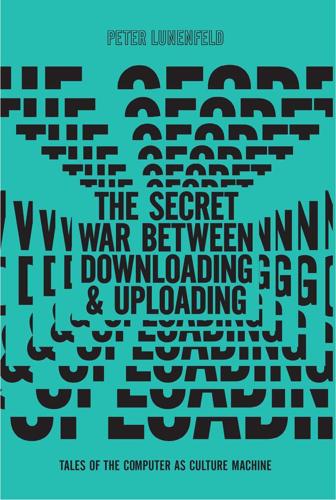
The Secret War Between Downloading and Uploading: Tales of the Computer as Culture Machine
by
Peter Lunenfeld
Published 31 Mar 2011
Joshua Driggs aka ZapWizard, “The Real Wood iPod,” available at <http://www.macmod.com/content/view/363/101/>. 25 . There has long been a split in the literature on gaming between narratologists, who emphasize the “stories” that video games generate, and the ludologists, who concentrate on game play as primary. See Ian Bogost, Unit Operations: An Approach to Videogame Criticism (Cambridge, MA: MIT Press, 2006), 68. 26 . The sixth chapter of R. Buckminster Fuller’s Critical Path (New York: St. Martin’s Press, 1981) is devoted to the world game, and the Buckminster Fuller Institute maintains a page on its cite with numerous resources, available at <http://www.bfi.org/our_programs/who_is_buckminster_fuller/design_science/ world_game>.

Humankind: Solidarity With Non-Human People
by
Timothy Morton
Published 14 Oct 2017
Nicolas Shumway, Dean of Humanities at Rice, deserves a special mention for his untiring belief in what I do. I’m forever in his debt. So many people shared thoughts and suggestions, kindness and support. Among them were Blaise Agüera y Arcas, Heitham Al-Sayed, Ian Balfour, Andrew Battaglia, Anna Bernagozzi, Daniel Birnbaum, Ian Bogost, Tanya Bonakdar, Marcus Boon, Dominic Boyer, David Brooks, Alex Cecchetti, Stephen Cairns, Eric Cazdyn, Ian Cheng, Kari Conte, Carolyn Deby, Nigel Clark, Juliana Cope, Laura Copelin, Annie Culver, Sarah Ellenzweig, Olafur Eliasson, Anna Engberg, Jane Farver, Dirk Felleman, João Florêncio, Mark Foster Gage, Peter Gershon, Hazel Gibson, Jóga Jóhannsdóttir, Jón Gnarr, Kathelin Gray, Sofie Grettve, Lizzy Grindy, Björk Guðmundsdóttir, Zora Hamsa, Graham Harman, Rosemary Hennessy, Erich Hörl, Emily Houlik-Ritchey, Cymene Howe, Edouard Isar, Luke Jones, Toby Kamps, Greg Lindquist, Annie Lowe, Ingrid Luquet-Gad, Karsten Lund, Boyan Manchev, Kenric McDowell, Tracy Moore, Rick Muller, Jean-Luc Nancy, Judy Natal, Patricia Noxolo, Hans Ulrich Obrist, Genesis P-Orridge, Solveig Øvstebø, Andrea Pagnes, Albert Pope, Asad Raza, Alexander Regier, Ben Rivers, Judith Roof, David Ruy, Mark Schmanko, Sabrina Scott, Nicolas Shumway, Solveig Sigurðardóttir, Emilija Škarnulytė, Gayatri Spivak, Haim Steinbach, Verena Stenke, Samuel Stoeltje, Susan Sutton, Jeff VanderMeer, Lucas van der Velden, Teodora Vikstrom, Jennifer Walshe, Sarah Whiting, Clint Wilson, Tom Wiscombe, Susanne Witzgall, Cary Wolfe, Annette Wolfsberger, Hyesoo Woo, Martyn Woodward, Els Woudstra and Jonas Žukauskas.

Memory Machines: The Evolution of Hypertext
by
Belinda Barnet
Published 14 Jul 2013
Online: http://www.markbernstein.org/elements/atzenbeck.pdf (accessed March 2012). Bernstein, Mark, Jay David Bolter, Michael Joyce and Elli Mylonas. 1991. ‘Architectures for Volatile Hypertexts’. In Hypertext ’91 Proceedings, edited by John J. Leggett, 243–60. San Antonio: ACM. Bogost, Ian. 2010. ‘Cow Clicker: The Making of an Obsession’. Ian Bogost Blog, 21 July. Online: http://www.bogost.com/blog/cow_clicker_1.shtml (accessed March 2012). Bolter, Jay David. 1984. Turing’s Man: Western Culture in the Computer Age. Chapel Hill: University of North Carolina Press. . 1985. ‘The Idea of Literature in the Electronic Medium’. Topic 39: 23–34. . 1991.

The End of Big: How the Internet Makes David the New Goliath
by
Nicco Mele
Published 14 Apr 2013
My two long-suffering business partners, Joshua Wachs and Justin Pinder, have taken many risks to make this book happen, and for that I am grateful. And then there were all the people who took time out of their day to let me interview them, including but not limited to: Adrian Arroyo, Kieran Brenner, Ian Bogost, Rodney Cocks, Anthony DeRosa, Andy Eggers, Pete Forsyth, Katie Goodwin & Chris Francis, Neal Gorenflo, Brian Halligan, Ben Kaufman, Matt Macdonald, Nathaniel Pearlman, Bre Pettis, Hillary Rosen, Doc Searles, Michael Silberman, Maria Thomas, Mark Walsh, and David Weinberger. A preemptive thank you to Dick Auletta and his team at R.

An Ugly Truth: Inside Facebook's Battle for Domination
by
Sheera Frenkel
and
Cecilia Kang
Published 12 Jul 2021
Stamos was Yahoo’s information security officer: Arik Hesseldahl, “Yahoo to Name TrustyCon Founder Alex Stamos as Next Chief Information Security Officer,” Vox, February 28, 2014. 7. he discovered that the vulnerability: Joseph Menn, “Yahoo Scanned Customer Emails for U.S. Intelligence,” Reuters, October 4, 2016. 8. “Russia, if you’re listening”: Michael S. Schmidt, “Trump Invited the Russians to Hack Clinton. Were They Listening?,” New York Times, July 13, 2018. 9. his campaign was busily buying up millions: Ian Bogost and Alexis C. Madrigal, “How Facebook Works for Trump,” Atlantic, April 17, 2020. 10. Over the last few years, the campaigns: Davey Alba, “How Duterte Used Facebook to Fuel the Philippine Drug War,” Buzzfeed News, September 4, 2018. 11. The Fancy Bear hackers had stolen: Ben Chapman, “George Soros Documents Published ‘by Russian Hackers’ say US Security Services,” Independent, August 15, 2016. 12. in November 2015, Russia’s Office of the Prosecutor-General: Jennifer Ablan, “Russia Bans George Soros Foundation as State Security ‘Threat’,” Reuters, November 30, 2015.

All Your Base Are Belong to Us: How Fifty Years of Video Games Conquered Pop Culture
by
Harold Goldberg
Published 5 Apr 2011
Uncharted 2: Among Thieves, with its nineteenth-century penny dreadful influence on a story surrounding Marco Polo’s lost treasure, let you feel as though you were in a melodramatic movie with all the spills and thrills of an Indiana Jones adventure. So these are more than toys, as educator and game designer Ian Bogost suggests in his book Persuasive Games. Games can have their own kind of rhetoric—not oratory, but a procedural rhetoric that lures us into thinking and changing our points of view. So-called serious games with low budgets are used in politics, education, and medicine not to make money or to be played by millions.
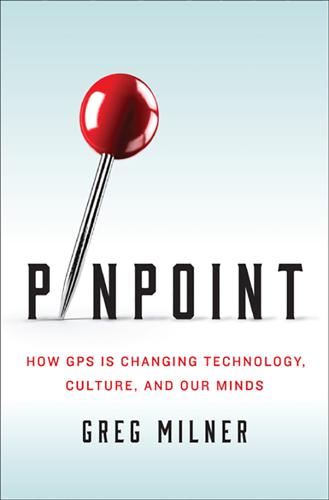
Pinpoint: How GPS Is Changing Our World
by
Greg Milner
Published 4 May 2016
French, “Historical Overview of Automobile Navigation Technology,” Proceedings of the Thirty-Sixth IEEE Vehicular Technology Conference (Institute of Electrical and Electronics Engineers, 1986), 350–8. 121 Nolan Bushnell: Alexis C. Madrigal, “Chuck E. Cheese’s, Silicon Valley Startup: The Origins of the Best Pizza Chain Ever,” Atlantic, July 17, 2013, http://www.theatlantic.com/technology/archive/2013/07/chuck-e-cheeses-silicon-valley-startup-the-origins-of-the-best-pizza-chain-ever/277869/; Ian Bogost, “Persuasion and Gamespace,” in Space Time Play: Computer Games, Architecture and Urbanism: The Next Level, edited by Friedrich von Boories, Steffen P. Walz, and Matthias Böttger, 304–11 (Basel, Switzerland: Birkhäuser, 2007). 124 If a team were building a robot: Benjamin J. Kuipers, “The Cognitive Map: Could It Have Been Any Other Way?”

Zucked: Waking Up to the Facebook Catastrophe
by
Roger McNamee
Published 1 Jan 2019
Even after the first salvo of press appearances by Zuck and Sheryl, the pressure on Facebook continued to grow. On March 21, a Facebook user filed a proposed class action lawsuit in San Jose, California. That same day, this showed up on Twitter: On March 22, a game designer by the name of Ian Bogost published a piece in The Atlantic titled, “My Cow Game Extracted Your Facebook Data.” For a spell during 2010 and 2011, I was a virtual rancher of clickable cattle on Facebook. . . . Facebook’s IPO hadn’t yet taken place, and its service was still fun to use—although it was littered with requests and demands from social games, like FarmVille and Pet Society.

Because Internet: Understanding the New Rules of Language
by
Gretchen McCulloch
Published 22 Jul 2019
The New York Times. www.nytimes.com/2012/04/14/technology/instagram-founders-were-helped-by-bay-area-connections.html. a new format for posts: Robinson Meyer. August 3, 2016. “Why Instagram ‘Borrowed’ Stories from Snapchat.” The Atlantic. www.theatlantic.com/technology/archive/2016/08/cameras-with-constraints/494291/. Ian Bogost. May 3, 2018. “Why ‘Stories’ Took Over Your Smartphone.” The Atlantic. www.theatlantic.com/technology/archive/2018/05/smartphone-stories-snapchat-instagram-facebook/559517/. “Third place conversation”: Ray Oldenburg. 1989. The Great Good Place: Cafes, Coffee Shops, Community Centers, Beauty Parlors, General Stores, Bars, Hangouts, and How They Get You Through the Day.

Custodians of the Internet: Platforms, Content Moderation, and the Hidden Decisions That Shape Social Media
by
Tarleton Gillespie
Published 25 Jun 2018
; Reagle, Good Faith Collaboration. 63Greg Seals, “Facebook Tells Drag Queens to Use Their Legal Names or Risk Losing Their Profiles,” Daily Dot, September 11, 2014, http://www.dailydot.com/lifestyle/facebook-demands-drag-queens-change-names/; Lingel and Gillespie, “One Name to Rule Them All.” 64Chris Cox, Facebook, October 1, 2014, https://www.facebook.com/chris.cox/posts/10101301777354543. 65Ibid. 66Taylor Hatmaker, “RealNamePolice and the Real Story behind Facebook’s Name Policy Fumble,” Daily Dot, October 3, 2014, http://www.dailydot.com/technology/realnamepolice-facebook-real-names-policy/. 67https://twitter.com/RealNamesBack/status/514182271687852032 (account since suspended). 68https://twitter.com/RealNamesBack/status/514167671487602689 (account since suspended). 69This suggests that Facebook probably received more flags than just those from a single individual, contrary to its apology statement. 70Hatmaker, “RealNamePolice.” 71Ben Quinn, “YouTube Staff Too Swamped to Filter Out All Terror-Related Content,” Guardian, January 28, 2015, https://www.theguardian.com/technology/2015/jan/28/youtube-too-swamped-to-filter-terror-content. 72Sam Gustin, “How Google Beat Viacom in the Landmark YouTube Copyright Case—Again,” Time, April 19, 2013, http://business.time.com/2013/04/19/how-google-beat-viacom-in-the-landmark-youtube-copyright-case-again/. 73Josh Constine, “Facebook Spares Humans by Fighting Offensive Photos with AI,” TechCrunch, May 31, 2016, https://techcrunch.com/2016/05/31/terminating-abuse/. 74Brian Barrett, “This Algorithm Wants to Find Who’s Naked on the Internet,” Wired, June 24, 2915, http://www.wired.com/2015/06/nude-recognition-algorithmia/. 75boyd, Levy, and Marwick, “The Networked Nature of Algorithmic Discrimination”; Citron and Pasquale, “The Scored Society”; O’Neil, Weapons of Math Destruction; Pasquale, The Black Box Society; Shorey and Howard, “Automation, Big Data and Politics”; Tufekci, “Algorithmic Harms beyond Facebook and Google”; Zarsky, “The Trouble with Algorithmic Decisions”; Lauren Kirchner, “When Discrimination Is Baked into Algorithms,” Atlantic, September 6, 2015, https://www.theatlantic.com/business/archive/2015/09/discrimination-algorithms-disparate-impact/403969/. 76Gillespie, “Algorithm”; Ian Bogost, “The Cathedral of Computation,” Atlantic, January 1, 2015, https://www.theatlantic.com/technology/archive/2015/01/the-cathedral-of-computation/384300/; Steve Lohr, “Algorithms Get a Human Hand in Steering Web,” New York Times, March 10, 2013, http://www.nytimes.com/2013/03/11/technology/computer-algorithms-rely-increasingly-on-human-helpers.html. 77Victoria Grand (YouTube), “Making YouTube a Safer Place,” Google Europe Blog, June 22, 2009, https://europe.googleblog.com/2009/06/making-youtube-safer-place.html. 78This feature was removed once YouTube’s Safety Mode was introduced, which hides all comments.
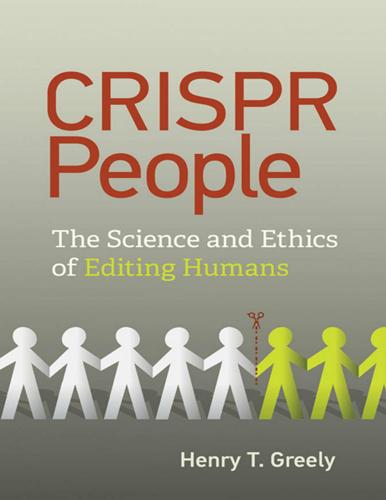
CRISPR People: The Science and Ethics of Editing Humans
by
Henry T. Greely
Published 22 Jan 2021
A good source for an understandable description of CRISPR and a history of its discovery and development can be found in Jennifer A. Doudna and Samuel H. Sternberg, A Crack in Creation: Gene Editing and the Unthinkable Power to Control Evolution (New York: Houghton Mifflin Harcourt, 2017). Doudna is widely accepted as one of the crucial (nonbacterial) inventors of CRISPR; Sternberg was her graduate student. 2. Ian Bogost, “CRISPR Has a Terrible Name,” The Atlantic, April 2017, https://www.theatlantic.com/science/archive/2017/04/why-does-a-transformative-biotechnology-sound-like-a-cereal-bar/522639. 3. Y. Ishino, H. Shinagawa, K. Makino, et al., “Nucleotide Sequence of the iap Gene, Responsible for Alkaline Phosphatase Isoenzyme Conversion in Escherichia coli, and Identification of the Gene Product,” Journal of Bacteriology 169, no. 12 (1987): 5429–5433, https://doi.org/10.1128/jb.169.12.5429-5433.1987. 4.

The Age of Surveillance Capitalism
by
Shoshana Zuboff
Published 15 Jan 2019
Typically, this involves importing a few components, such as reward points and levels of advancement, in order to engineer behaviors that serve the company’s immediate interests, with programs such as customer loyalty schemes or internal sales competitions. One analyst compiled a survey of more than ninety such “gamification cases,” complete with return-on-investment statistics.35 Ian Bogost, a professor of interactive computing at Georgia Tech and a digital culture observer, insists that these systems should be called “exploitationware” rather than games because their sole aim is behavior manipulation and modification.36 Pokémon Go takes these capabilities in a wholly new direction, running game players through the real world, but not for the sake of the game they think they are playing.
…
—a Literature Review of Empirical Studies on Gamification,” in 47th Hawaii International Conference on System Sciences, 2014, 3025–34, https://doi.org/10.1109/HICSS.2014.377; Carina Soledad González and Alberto Mora Carreño, “Methodological Proposal for Gamification in the Computer Engineering Teaching,” 2014 International Symposium on Computers in Education (SIIE), 1–34; Dick Schoech et al., “Gamification for Behavior Change: Lessons from Developing a Social, Multiuser, Web-Tablet Based Prevention Game for Youths,” Journal of Technology in Human Services 31, no. 3 (2013): 197–217, https://doi.org/10.1080/15228835.2013.812512. 35. Yu-kai Chou, “A Comprehensive List of 90+ Gamification Cases with ROI Stats,” Yu-Kai Chou: Gamification & Behavioral Design, January 23, 2017, http://yukaichou.com/gamification-examples/gamification-stats-figures. 36. Ian Bogost, “Persuasive Games: Exploitationware,” Gamasutra, May 3, 2011, http://www.gamasutra.com/view/feature/134735/persuasive_games_exploita tionware.php; Adam Alter, Irresistible: The Rise of Addictive Technology and the Business of Keeping Us Hooked (New York: Penguin, 2017). 37. Jessica Conditt, “The Pokémon Go Plus Bracelet Is Great for Grinding,” Engadget, September 17, 2016, https://www.engadget.com/2016/09/17/pokemon-go-plus-hands-on; Sarah E.
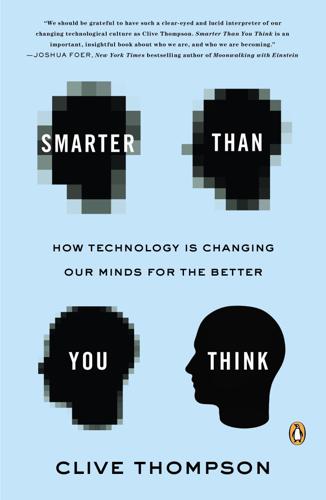
Smarter Than You Think: How Technology Is Changing Our Minds for the Better
by
Clive Thompson
Published 11 Sep 2013
That includes Tricia Wang, An Xiao Mina, Debbie Chachra, Liz Lawley, Zeynep Tufekci, Clay Shirky, Brooke Gladstone, Tom Igoe, Max Whitney, Terri Senft, Misha Tepper, Fred Kaplan, Howard Rheingold, danah boyd, Liz Lawley, Nick Bilton, Gary Marcus, Heidi Siwak, Ann Blair, Eli Pariser, Ethan Zuckerman, Ian Bogost, Fred Benenson, Heather Gold, Douglas Rushkoff, Rebecca MacKinnon, Cory Menscher, Mark Belinsky, Quinn Norton, Anil Dash, Cathy Marshall, Elizabeth Stock, Philip Howard, Denise Hand, Robin Sloan, Tim Carmody, Don Tapscott, Steven Johnson, Kevin Kelly, Nina Khosla, Laura Fitton, Jillian York, Hilary Mason, Craig Mod, Bre Pettis, Glenn Kelman, Susan Cain, Noah Schachtman, Irin Carmon, Matthew Battles, Cathy Davidson, Linda Stone, Jess Kimball, Phil Libin, Kati London, Jim Marggraff, Dan Zalewski, Sasha Nemecek, Laura Miller, Brian McNely, Duncan Watts, Kenyatta Cheese, Nora Abousteit, Deanna Zandt, David Wallis, Nick Denton, Alissa Quart, Stan James, Andrew Hearst, Gary Stager, Evan Selinger, Steven Demmler, and Vint Cerf.

Radical Technologies: The Design of Everyday Life
by
Adam Greenfield
Published 29 May 2017
I’d also like to thank Mark Martin and his editorial team at Verso, for their good cheer, patience with my last-minute revisions, and indulgence of my more-than-occasional insistence on a particular way of wording things; designers Neil Donnelly and Ben Fehrman-Lee and typesetter Matt Gavan, for transforming those words into an aesthetically pleasing object; and publicists Jennifer Tighe and Wes House, for making sure people who might have an interest in that object know that it exists. Nothing is ever achieved alone, and to whatever degree that you’ve enjoyed this book, you have their labors to thank for it. I am grateful to the insight, solidarity, support and energy furnished, in various ways, by Ash Amin, Jon Ardern, Timo Arnall, John Bingham-Hall, Ian Bogost, Shumi Bose, Jaya Klara Brekke, Ricky and Mika Burdett, Alberto Corsín Jiménez, Aimee Meredith Cox, Ayona Datta, Sally Davies, Benjie de la Peña, Nicholas de Monchaux, Nigel Dodd, Nick Durrant, Warren Ellis, Nuno Ferreira da Cruz, David Faris, Daisy Froud, Andrei Goncharov, Stephen Graham, Suzi Hall, Alaina Harkness, Usman Haque, Chris Heathcote, Catarina Heeckt, Robin Howie, Sha Hwang, Tom Igoe, Anab Jain, Shanthi Kalathil, Sophia Kakembo, Michelle Kasprzak, Mike Kuniavsky, Laura Kurgan, Annie Kwon, Derek Lindner, David Madden, Adrian McEwen, Justin McGuirk, Ana Méndez de Andés, Michal Migurski, Dietmar Offenhuber, Frank Pasquale, Bre Pettis, Lucia Pietroiusti, Alison Powell, Pamela Puchalski, Jack Linchuan Qiu, Philipp Rode, Saskia Sassen, Gaia Scagnetti, Fred Scharmen, Jack Schulze, Susan Wile Schwarz, Brett Scott, Richard Sennett, Steven Shaviro, Jonathan Silver, Stavros Stavrides, Cordy Swope, Rena Tom, Shan Vahidy, Tricia Wang, Gill Wildman, Amanda Marisa Williams, Sarah Williams, Jillian C.
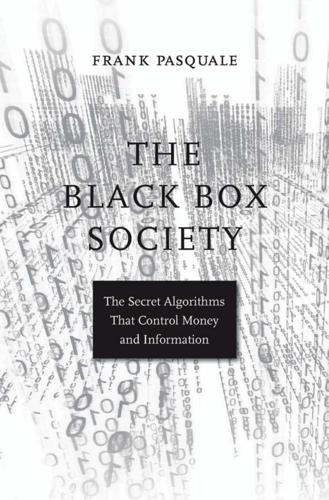
The Black Box Society: The Secret Algorithms That Control Money and Information
by
Frank Pasquale
Published 17 Nov 2014
Drone Strikes,” Mashable, February 7, 2014, http://mashable .com /2014 /02/07/apple-app-tracks-drone-strikes/. 248 NOTES TO PAGES 63–64 28. Benjamin Poynter, in an interview with GameScenes (transcript posted Oct. 2012). Available at http://www.gamescenes.org/2012/10/interview.html. On persuasive gaming generally, see Ian Bogost, Persuasive Games (Cambridge, MA: MIT Press, 2007). 29. Yves Smith, “Wired’s Embarrassing Whitewash of Foxconn,” Naked Capitalism (blog), February 8, 2012, http://www.nakedcapitalism.com /2012/02 /wireds-embarrassing-whitewash-of-foxconn.html. 30. There is a pattern here; “Sweatshop HD was removed from Apple’s store because it was uncomfortable with the re- creation of a sweatshop.”

Gamers at Work: Stories Behind the Games People Play
by
Morgan Ramsay
and
Peter Molyneux
Published 28 Jul 2011
I would recognize many people for their time, insight, and/or willingness to make introductions: Al Lowe, Alan Wasserman, Andy Schatz, Brenda Brathwaite, Casey Wardynski, Cathy Campos, Cory Ondrejka, David Edery, David Perry, Doug Whatley, Erin Hoffman, Gabe Newell, Genevieve Waldman, Greg Zeschuk, Greta Melinchuk, Guy Kawasaki, Hal Halpin, Ian Bogost, Jane Cavanagh, Jason Della Rocca, Jason Kay, Jeff Braun, Jim Buck, John Romero, Joseph Olin, Justin Berenbaum, Kellee Santiago, Ken Dopher, Kristina Kirk, Mark Friedler, Matt Shores, Megan Tiernan, Mike Capps, Mike Morhaime, Nancy Carlston, Pam Pearlman, Randy Pitchford, Raph Koster, Ray Muzyka, Richard Bartle, Rodolfo Rosini, Sam Ford, Shon Damron, Sue Coldwell, Suzanne Goodman, Tawnya Barrett, and Tim Schafer.

The Stack: On Software and Sovereignty
by
Benjamin H. Bratton
Published 19 Feb 2016
Software Studies Matthew Fuller, Lev Manovich, and Noah Wardrip-Fruin, editors Expressive Processing: Digital Fictions, Computer Games, and Software Studies, Noah Wardrip-Fruin, 2009 Code/Space: Software and Everyday Life, Rob Kitchin and Martin Dodge, 2011 Programmed Visions: Software and Memory, Wendy Hui Kyong Chun, 2011 Speaking Code: Coding as Aesthetic and Political Expression, Geoff Cox and Alex McLean, 2012 10 PRINT CHR$(205.5+RND(1));: GOTO 10, Nick Montfort, Patsy Baudoin, John Bell, Ian Bogost, Jeremy Douglass, Mark Marino, Michael Mateas, Casey Reas, Mark Sample, and Noah Vawter, 2012 The Imaginary App, Paul D. Miller and Svitlana Matviyenko, 2014 The Stack: On Software and Sovereignty, Benjamin H. Bratton, 2015 The Stack On Software and Sovereignty Benjamin H. Bratton The MIT Press Cambridge, Massachusetts London, England © 2015 Massachusetts Institute of Technology All rights reserved.